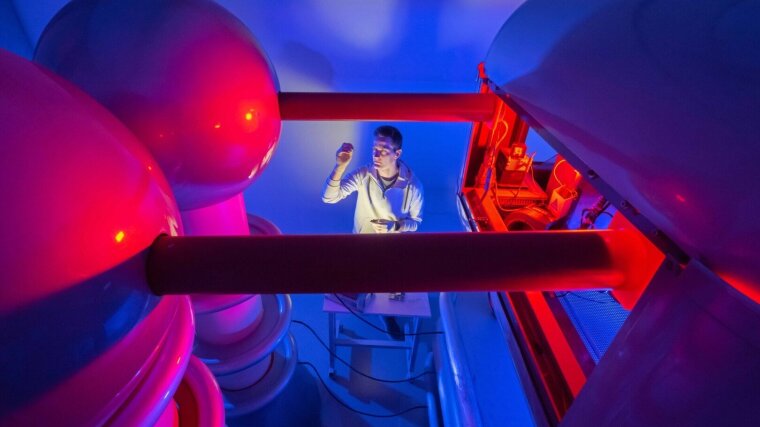
- Light
Published: | By: Montserrat Capellas Espuny
Source article
PhD student Christian T. Plass looks at a sample with individual nanowires on a thin layer of silicon dioxide on silicon. Only the substrate can be seen, as the nanowires are too tiny.
Image: Jens Meyer (University of Jena)A team from the Friedrich Schiller University Jena has set up a new streak camera on ID16B, which can measure very fast kinetic phenomena present in light emission after receiving an X-ray pulse. The camera is now available to the user community to study complex carrier dynamics with spatio-temporal resolutions. The first results are published in Advanced Science this week.
Research on luminescent atoms incorporated in nanostructures give detailed insights on the electronic system and carrier processes of these materials, such as the determination of electronic levels, electron-phonon interactions or the identification of defects. In this respect, such color centres in semiconductors, which are single-photon sources that emit light, have gained enormous importance for quantum technologies lately.
Now researchers from the Friedrich Schiller University Jena have managed to measure how 10,000 atoms behave as colour centres in a semiconductor nanowire once they receive an X-ray pulse from the ESRF on ID16B.
These results are only possible thanks to the combination of the Extremely Brilliant Source (EBS) beam, the capabilities of ID16B and the new streak camera that the team from the University of Jena installed on the beamline back in 2021. The camera complements the existing set-up of optical luminescence detection on ID16B: “We’ve added one more dimension: time”, explains Christian Plass, PhD student in Jena and first author of the paper. Basically, the researchers excite the system with one pulse of the new EBS, the material emits light, and they can track how the light decays with time and what wavelength of colour there is at a certain moment, using nano X-ray excited optical luminescence.
High intense beam focused to a very small size
Carsten Ronning, leading researcher at Jena, corresponding author of the paper and a long-term user at the ESRF, explains the value of the new EBS and the ID16B capabilities at the nanolevel: “It is very impressive that you get such a high intense beam with the new machine, but what it is even more impressive is that we can focus to such a small size, and in the future we may be able to address single colour centers”.
In addition to ultra-high sensitivity (detection of single photons), the streak camera can capture spatial (or spectral) data simultaneous in a wide wavelength range (200-850 nm) with less than 40 ps temporal resolution (trigger jitter < 20 ps and repetition rate max 20 MHz in fastest range). Thus, in a single shot the detector delivers intensity versus time versus wavelength information.
In addition to colour centers, the camera can be useful in research on pervoskite solar cells, nano-photonic investigations, as well as correlation measurements between structure and electronic properties of any semiconductor.
Success of this project is thanks to the extremely smooth collaboration
The implementation of the streak camera was funded by the German Ministry of Education and Research (BMBF) and it was the object of an ESRF Long-Term Proposal. Both the ESRF staff and the researchers of the University of Jena worked together to install the camera and develop an extremely complex software to make it work. “The success of this project is thanks to the extremely smooth collaboration between teams, not only scientists but also software developers, at the ESRF end”, adds Ronning.
For Gema Martínez Criado, director of research at the ESRF and also part of the team, the new streak camera will be a game changer for the user community: “We have many user groups interested in a direct visualization of the excited-state recombination dynamics, including effective carrier lifetimes, behind the local X-ray excited optical luminescence, so having this new tool with unprecedented spatial, spectral and temporal resolutions will enable them to go into much more detail and to extend the knowledge in the field more rapidly”.
The results of this first study, whilst fundamental, could lead to further studies on future applications in quantum communications, such as using nanowires as waveguides for light, like optical fibres do today, but on a nano-scale.
Original publication:
Christian T. Plass, Valentina Bonino, Maurizio Ritzer, Lukas R. Jäger, Vicente Rey-Bakaikoa, Martin Hafermann, Jaime Segura-Ruiz, Gema Martínez-Criado, Carsten Ronning: Spatially Resolved Dynamics of Cobalt Color Centers in ZnO Nanowires, Advanced Science 2205304 (2022), DOI: https://doi.org/10.1002/advs.202205304External link
